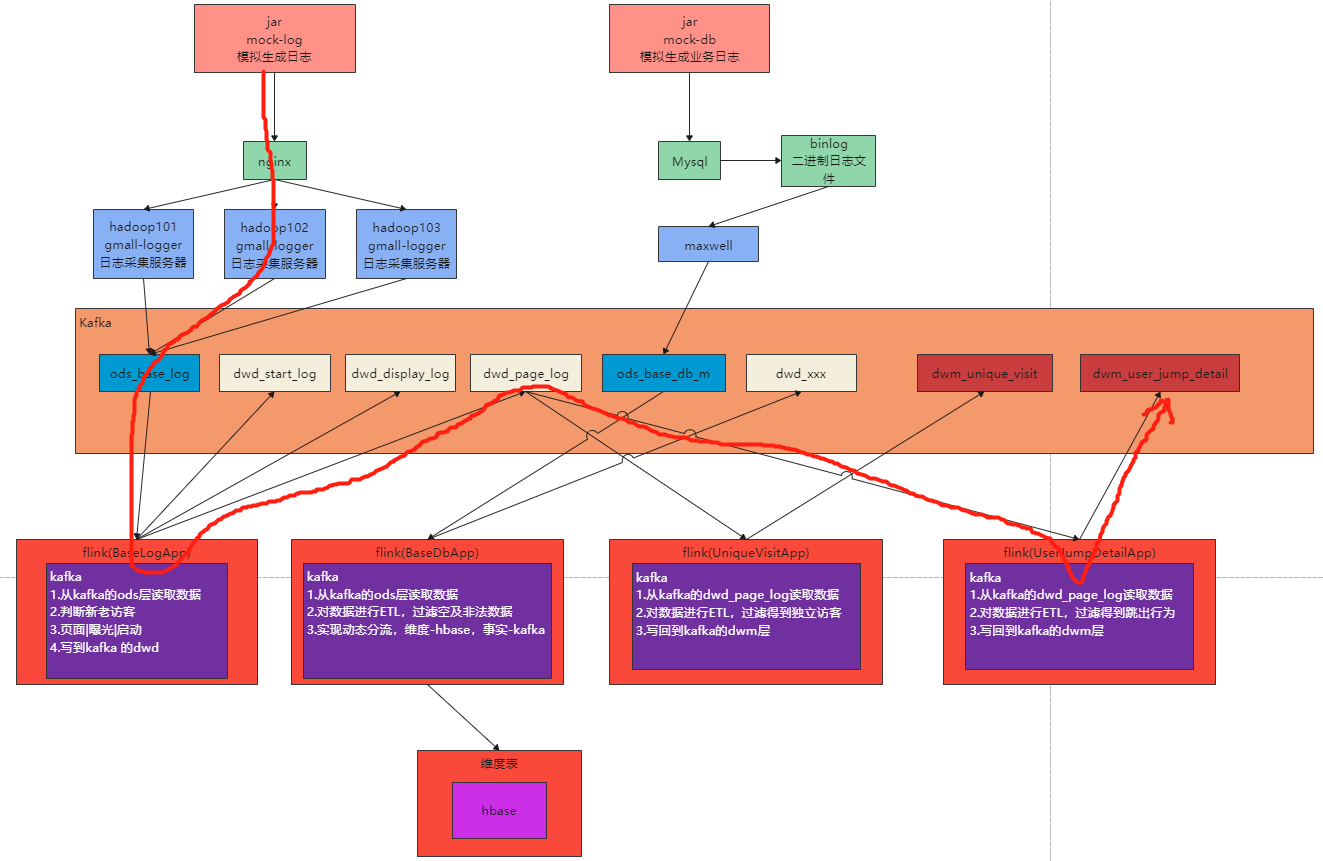8.Flink实时项目之CEP计算访客跳出
作者:互联网
1.访客跳出明细介绍
首先要识别哪些是跳出行为,要把这些跳出的访客最后一个访问的页面识别出来。那么就要抓住几个特征:
该页面是用户近期访问的第一个页面,这个可以通过该页面是否有上一个页面(last_page_id)来判断,如果这个表示为空,就说明这是这个访客这次访问的第一个页面。
首次访问之后很长一段时间(自己设定),用户没继续再有其他页面的访问。
这第一个特征的识别很简单,保留 last_page_id 为空的就可以了。但是第二个访问的判断,其实有点麻烦,首先这不是用一条数据就能得出结论的,需要组合判断,要用一条存在的数据和不存在的数据进行组合判断。而且要通过一个不存在的数据求得一条存在的数据。更麻烦的他并不是永远不存在,而是在一定时间范围内不存在。那么如何识别有一定失效的组合行为呢?
最简单的办法就是 Flink 自带的 CEP 技术。这个 CEP 非常适合通过多条数据组合来识别某个事件。
用户跳出事件,本质上就是一个条件事件加一个超时事件的组合。
-
流程图

2.代码实现
创建任务类UserJumpDetailApp.java,从kafka读取页面日志
import com.zhangbao.gmall.realtime.utils.MyKafkaUtil;
import org.apache.flink.configuration.Configuration;
import org.apache.flink.runtime.state.filesystem.FsStateBackend;
import org.apache.flink.streaming.api.CheckpointingMode;
import org.apache.flink.streaming.api.datastream.DataStreamSource;
import org.apache.flink.streaming.api.environment.StreamExecutionEnvironment;
import org.apache.flink.streaming.connectors.kafka.FlinkKafkaConsumer;
/**
* @author zhangbao
* @date 2021/10/17 10:38
* @desc
*/
public class UserJumpDetailApp {
public static void main(String[] args) {
//webui模式,需要添加pom依赖
StreamExecutionEnvironment env = StreamExecutionEnvironment.createLocalEnvironmentWithWebUI(new Configuration());
// StreamExecutionEnvironment env1 = StreamExecutionEnvironment.createLocalEnvironment();
//设置并行度
env.setParallelism(4);
//设置检查点
// env.enableCheckpointing(5000, CheckpointingMode.EXACTLY_ONCE);
// env.getCheckpointConfig().setCheckpointTimeout(60000);
// env.setStateBackend(new FsStateBackend("hdfs://hadoop101:9000/gmall/flink/checkpoint/userJumpDetail"));
// //指定哪个用户读取hdfs文件
// System.setProperty("HADOOP_USER_NAME","zhangbao");
//从kafka读取数据源
String sourceTopic = "dwd_page_log";
String group = "user_jump_detail_app_group";
String sinkTopic = "dwm_user_jump_detail";
FlinkKafkaConsumer<String> kafkaSource = MyKafkaUtil.getKafkaSource(sourceTopic, group);
DataStreamSource<String> kafkaDs = env.addSource(kafkaSource);
kafkaDs.print("user jump detail >>>");
try {
env.execute("user jump detail task");
} catch (Exception e) {
e.printStackTrace();
}
}
}3. flink CEP编程
官方文档:https://nightlies.apache.org/flink/flink-docs-release-1.12/dev/libs/cep.html
处理流程
1.从kafka读取日志数据
2.设定时间语义为事件时间并指定事件时间字段ts
3.按照mid分组
4.配置CEP表达式
-
1.第一次访问的页面:last_page_id == null
-
2.第一次访问的页面在10秒内,没有进行其他操作,没有访问其他页面
5.根据表达式筛选流
6.提取命中的数据
-
设定超时时间标识 timeoutTag
-
flatSelect 方法中,实现 PatternFlatTimeoutFunction 中的 timeout 方法。
-
所有 out.collect 的数据都被打上了超时标记
-
本身的 flatSelect 方法因为不需要未超时的数据所以不接受数据。
-
通过 SideOutput 侧输出流输出超时数据
7.将跳出数据写回到kafka
package com.zhangbao.gmall.realtime.app.dwm;
import com.alibaba.fastjson.JSON;
import com.alibaba.fastjson.JSONObject;
import com.zhangbao.gmall.realtime.utils.MyKafkaUtil;
import org.apache.flink.api.common.eventtime.SerializableTimestampAssigner;
import org.apache.flink.api.common.eventtime.WatermarkGenerator;
import org.apache.flink.api.common.eventtime.WatermarkGeneratorSupplier;
import org.apache.flink.api.common.eventtime.WatermarkStrategy;
import org.apache.flink.cep.CEP;
import org.apache.flink.cep.PatternFlatSelectFunction;
import org.apache.flink.cep.PatternFlatTimeoutFunction;
import org.apache.flink.cep.PatternStream;
import org.apache.flink.cep.pattern.Pattern;
import org.apache.flink.cep.pattern.conditions.SimpleCondition;
import org.apache.flink.configuration.Configuration;
import org.apache.flink.runtime.state.filesystem.FsStateBackend;
import org.apache.flink.streaming.api.CheckpointingMode;
import org.apache.flink.streaming.api.datastream.DataStream;
import org.apache.flink.streaming.api.datastream.DataStreamSource;
import org.apache.flink.streaming.api.datastream.KeyedStream;
import org.apache.flink.streaming.api.datastream.SingleOutputStreamOperator;
import org.apache.flink.streaming.api.environment.StreamExecutionEnvironment;
import org.apache.flink.streaming.api.windowing.time.Time;
import org.apache.flink.streaming.connectors.kafka.FlinkKafkaConsumer;
import org.apache.flink.util.Collector;
import org.apache.flink.util.OutputTag;
import java.util.List;
import java.util.Map;
/**
* @author zhangbao
* @date 2021/10/17 10:38
* @desc
*/
public class UserJumpDetailApp {
public static void main(String[] args) {
//webui模式,需要添加pom依赖
StreamExecutionEnvironment env = StreamExecutionEnvironment.createLocalEnvironmentWithWebUI(new Configuration());
// StreamExecutionEnvironment env1 = StreamExecutionEnvironment.createLocalEnvironment();
//设置并行度
env.setParallelism(4);
//设置检查点
// env.enableCheckpointing(5000, CheckpointingMode.EXACTLY_ONCE);
// env.getCheckpointConfig().setCheckpointTimeout(60000);
// env.setStateBackend(new FsStateBackend("hdfs://hadoop101:9000/gmall/flink/checkpoint/userJumpDetail"));
// //指定哪个用户读取hdfs文件
// System.setProperty("HADOOP_USER_NAME","zhangbao");
//从kafka读取数据源
String sourceTopic = "dwd_page_log";
String group = "user_jump_detail_app_group";
String sinkTopic = "dwm_user_jump_detail";
FlinkKafkaConsumer<String> kafkaSource = MyKafkaUtil.getKafkaSource(sourceTopic, group);
DataStreamSource<String> jsonStrDs = env.addSource(kafkaSource);
/*//测试数据
DataStream<String> jsonStrDs = env
.fromElements(
"{\"common\":{\"mid\":\"101\"},\"page\":{\"page_id\":\"home\"},\"ts\":10000} ",
"{\"common\":{\"mid\":\"102\"},\"page\":{\"page_id\":\"home\"},\"ts\":12000}",
"{\"common\":{\"mid\":\"102\"},\"page\":{\"page_id\":\"good_list\",\"last_page_id\":" +
"\"home\"},\"ts\":15000} ",
"{\"common\":{\"mid\":\"102\"},\"page\":{\"page_id\":\"good_list\",\"last_page_id\":" +
"\"detail\"},\"ts\":30000} "
);
dataStream.print("in json:");*/
//对读取到的数据进行结构转换
SingleOutputStreamOperator<JSONObject> jsonObjDs = jsonStrDs.map(jsonStr -> JSON.parseObject(jsonStr));
// jsonStrDs.print("user jump detail >>>");
//从flink1.12开始,时间语义默认是事件时间,不需要额外指定,如果是之前的版本,则要按以下方式指定事件时间语义
//env.setStreamTimeCharacteristic(TimeCharacteristic.EventTime);
//指定事件时间字段
SingleOutputStreamOperator<JSONObject> jsonObjWithTSDs = jsonObjDs.assignTimestampsAndWatermarks(
WatermarkStrategy.<JSONObject>forMonotonousTimestamps().withTimestampAssigner(
new SerializableTimestampAssigner<JSONObject>() {
@Override
public long extractTimestamp(JSONObject jsonObject, long l) {
return jsonObject.getLong("ts");
}
}
));
//按照mid分组
KeyedStream<JSONObject, String> ketByDs = jsonObjWithTSDs.keyBy(
jsonObject -> jsonObject.getJSONObject("common").getString("mid")
);
/**
* flink CEP表达式
* 跳出规则,满足两个条件:
* 1.第一次访问的页面:last_page_id == null
* 2.第一次访问的页面在10秒内,没有进行其他操作,没有访问其他页面
*/
Pattern<JSONObject, JSONObject> pattern = Pattern.<JSONObject>begin("first")
.where( // 1.第一次访问的页面:last_page_id == null
new SimpleCondition<JSONObject>() {
@Override
public boolean filter(JSONObject jsonObject) throws Exception {
String lastPageId = jsonObject.getJSONObject("page").getString("last_page_id");
System.out.println("first page >>> "+lastPageId);
if (lastPageId == null || lastPageId.length() == 0) {
return true;
}
return false;
}
}
).next("next")
.where( //2.第一次访问的页面在10秒内,没有进行其他操作,没有访问其他页面
new SimpleCondition<JSONObject>() {
@Override
public boolean filter(JSONObject jsonObject) throws Exception {
String pageId = jsonObject.getJSONObject("page").getString("page_id");
System.out.println("next page >>> "+pageId);
if(pageId != null && pageId.length()>0){
return true;
}
return false;
}
}
//时间限制模式,10S
).within(Time.milliseconds(10000));
//将cep表达式运用到流中,筛选数据
PatternStream<JSONObject> patternStream = CEP.pattern(ketByDs, pattern);
//从筛选的数据中再提取数据超时数据,放到侧输出流中
OutputTag<String> timeOutTag = new OutputTag<String>("timeOut"){};
SingleOutputStreamOperator<Object> outputStreamDS = patternStream.flatSelect(
timeOutTag,
//获取超时数据
new PatternFlatTimeoutFunction<JSONObject, String>() {
@Override
public void timeout(Map<String, List<JSONObject>> map, long l, Collector<String> collector) throws Exception {
List<JSONObject> first = map.get("first");
for (JSONObject jsonObject : first) {
System.out.println("time out date >>> "+jsonObject.toJSONString());
//所有 out.collect 的数据都被打上了超时标记
collector.collect(jsonObject.toJSONString());
}
}
},
//获取未超时数据
new PatternFlatSelectFunction<JSONObject, Object>() {
@Override
public void flatSelect(Map<String, List<JSONObject>> map, Collector<Object> collector) throws Exception {
//不超时的数据不提取,所以这里不做操作
}
}
);
//获取侧输出流的超时数据
DataStream<String> timeOutDs = outputStreamDS.getSideOutput(timeOutTag);
timeOutDs.print("jump >>> ");
//将跳出数据写回到kafka
timeOutDs.addSink(MyKafkaUtil.getKafkaSink(sinkTopic));
try {
env.execute("user jump detail task");
} catch (Exception e) {
e.printStackTrace();
}
}
}
测试数据
将从kafka读取数据的方式切换成固定数据内容,如下:
//测试数据
DataStream<String> jsonStrDs = env
.fromElements(
"{\"common\":{\"mid\":\"101\"},\"page\":{\"page_id\":\"home\"},\"ts\":10000} ",
"{\"common\":{\"mid\":\"102\"},\"page\":{\"page_id\":\"home\"},\"ts\":12000}",
"{\"common\":{\"mid\":\"102\"},\"page\":{\"page_id\":\"good_list\",\"last_page_id\":" +
"\"home\"},\"ts\":15000} ",
"{\"common\":{\"mid\":\"102\"},\"page\":{\"page_id\":\"good_list\",\"last_page_id\":" +
"\"detail\"},\"ts\":30000} "
);
dataStream.print("in json:");然后从dwm_user_jump_detail主题消费数据
./kafka-console-consumer.sh --bootstrap-server hadoop101:9092,hadoop102:9092,hadoop103:9092 --topic dwm_user_jump_detail
标签:Flink,org,flink,page,id,CEP,apache,import,访客 来源: https://www.cnblogs.com/zhangbaohpu/p/15987524.html